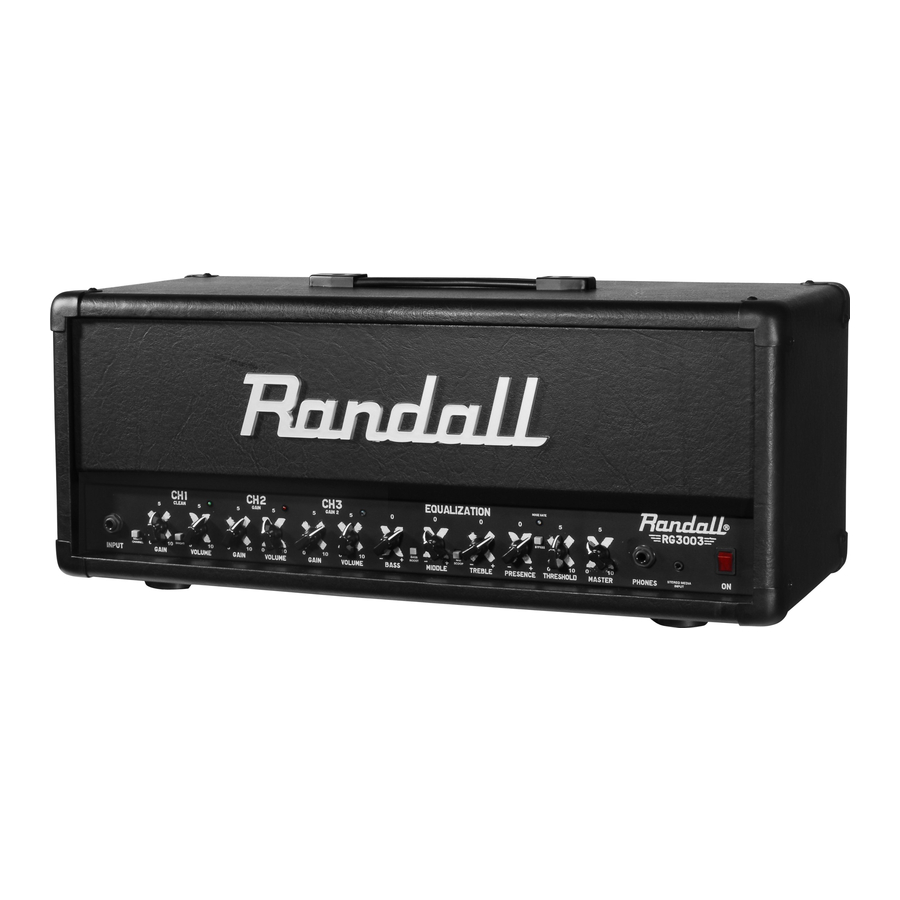
Advertisement
Table of Contents
Randall RG3003H - Guitar Amplifier Manual

Overview

- 1/4" Guitar Input.
- Channel selector switch toggles between 3 channels (footswitchable).
- Channel 1 gain controls amount of pre amp drive to channel 1.
- Bright switch adds Hi-Frequency EQ "Sparkle" to Channel 1.
- Channel 1 volume controls the amount of Channel 1 signal being sent to the master volume output.
- Channel 2 gain controls amount of pre amp overdrive to channel 2 - this will control the amount of "distortion".
- Channel 2 volume controls the amount of Channel 2 signal being sent to the master volume output.
- Channel 3 gain controls amount of preamp overdrive to channel 3 - this will control the amount of "searing distortion".
- Channel 3 volume controls the amount of Channel 3 signal being sent to the master volume output.
- The Bass knob controls the amount of low frequency equalization for the entire signal.
- The BASS BOOST will enhance low EQ -
use of boost with the Bass knob turned up can cause speaker damage. - The Middle knob controls the mid-frequency equalization for the entire signal.
- The MID SCOOP will decrease middle EQ similar to a "smiley face" setting on a graphic EQ.
- The Treble knob will control the amount of High frequency equalization for the entire signal.
- The Presence knob controls the uppermost High EQ frequencies above the Treble EQ shelf.
- NOISE GATE BYPASS removes the noise suppression circuit from the signal path.
- THRESHOLD controls the Noise Reduction function. After setting your preferred gain and tone settings, play your guitar very softly and turn up the threshold until it begins to eliminate the softest notes then turn it slightly under that "threshold".
- The MASTER VOLUME controls the amps volume going to whatever speaker cabinet is connected.
- The PHONES output allows for headphones to be plugged in - Note: speaker out is muted during headphone operation.
- STEREO MEDIA INPUT allows for 1/8" media source such as MP3 player to be inserted into signal to play along.
- The POWER switch turns the amplifier on and off.
- AC Inlet this jack is for the power cable supplied for your regions power - plug this cable in and the other side to the source.
- SPEAKER OUTPUT #1 is parallel with Speaker output #2 and utilizes standard 1/4" with MINIMUM 4 OHMS LOAD FOR BOTH OUTPUTS #1 & #2 -(this means maximum 2-8ohm cabs combined for both speaker outputs).
- SPEAKER OUTPUT #2 is parallel with Speaker output #1 and utilizes standard 1/4" with MINIMUM 4 OHMS LOAD FOR BOTH OUTPUTS #1 & #2 -(this means maximum 2-8ohm cabs combined for both speaker outputs).
- XLR Line Out provides "mic cable" output to carry amp output signal to PA, mixing console or recording device.
- GND LIFT - lifts the ground or "Earth" of the XLR OUT to avoid noise/hum when interfacing external gear via XLR.
- EFFECTS LOOP RETURN - plug 1/4" guitar cable from the output from Effects pedal or device here.
- EFFECTS LOOP SEND - plug 1/4" guitar cable to the input of Effects pedal or device here.
- FOOTSWITCH - 7 PIN DIN connector of included 4 button RF1503 footswitch inserts here to operate.
Technical Information
| RANDALL RG3003H |
| 300 Watts @ 4 Ω |
| 3 Channels with Gain and Level |
| Integrated Noise Gate with Threshold |
| EQ with Bass, Mid, Treble, Presence |
| Bass EQ Boost |
| Mid EQ Scoop |
| Spring Reverb |
| Switchable Serial effects loop |
| XLR Output with Ground Lift |
| RF1503 Footswitch switches all three Channels and Loop |

Documents / ResourcesDownload manual
Here you can download full pdf version of manual, it may contain additional safety instructions, warranty information, FCC rules, etc.
Advertisement
Thank you! Your question has been received!





















Need Assistance?
Do you have a question about the RG3003H that isn't answered in the manual? Leave your question here.